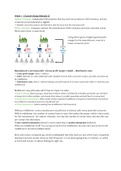Week 1 - Channel Design (Module 2)
Indirect channels: independent/third parties that buy and own products, hold inventory, and set
consumer prices (physical or digital)
→ Retailer owns the product and therefore sets the price (not the manufacturer)
Direct channels: company-owned, the manufacturer holds inventory and sets consumer prices
(brick and mortar or web store)
Going direct gives a higher (gross) profit
margin for the manufacturer, even at a
lower consumer price.
Manufacturer’s net total profit = (Gross profit margin x Sales) - Distribution costs
→ Gross profit margin: direct > indirect
→ Sales: depends on value added (provide valuable services that consumers expect, provide convenience)
by middlemen
→ Distribution costs: direct < indirect (doing it yourself may be a lot more costly than when it’s done by your
middlemen)
Middlemen may add value which has an impact on sales
→ Bulk breaking: allow buying in small lots (Unilever doesn’t sell Bertolli oil bottles per bottle, but sell them
in larger lots to their retailers, who break them down in smaller quantities and sell them to consumers)
→ Assortment convenience: offer a wide variety of goods (middlemen compose an assortment of products
from different manufacturers) (not only Bertolli oil)
→ Time convenience: reduce waiting time (middlemen hold inventory)
Without middlemen, every manufacturer would have to interact with every potential consumer.
With a middleman, the number of contact lines to reach the market decreases, which is less costly
for the manufacturer. For indirect channels, not only the number of contact lines, but also the cost
per contact line decreases.
A non-routine transaction (direct) is more costly than a routine transaction (indirect).
Why use middlemen at all? You can put an end to the middlemen, but you can’t put an end to the
middlemen’s functions (added value).
Brick and mortar companies go online (undebatable that they have to), but online-born companies
develop brick and mortar stores as well (Amazon). It’s not about going direct or indirect, or online
or brick and mortar; it’s about finding the right mix.
,Marketplaces
Agent: doesn’t buy/own products, doesn’t hold inventory, doesn’t set price → brings together
manufacturers and consumers and facilitate transactions
Blended model: online retailer ( Amazon responsible for price, logistics) + 3P marketplace (Amazon
facilitates an online platform for Levi’s, but Levi’s is responsible for price, logistics) (Amazon,
Bol.com) (pure retailer + pure marketplace)
Online retailer: owns products, holds inventory, sets price
3P marketplace (third party marketplace): owns products, holds inventory, sets price, online
retailer helps with payment/logistics (indirect online channel)
Direct channel: owns products, holds inventory, sets price
Direct channel vs Marketplace: direct channel manufacturer has to do everything from scratch
itself, in a marketplace the marketplace helps with things like logistics and payments
Online retailer: Gross profit = Gross margin * Units sold
→ Margin: difference between consumer price, price for which CoolBlue sells and the wholesale price at
which CoolBlue buys the product
→ Costs: inventory costs + fulfillment costs (costs to deliver products to consumers)
Marketplace: Gross profit = Commission * Units sold (+ minimal step-in fee)
→ Commission: percentage (5-20%) on every purchase that takes place through its marketplace
→ Costs: administrative costs
Consumer price - Step-in cost - Commission = Left for manufacturer (to cover production and
delivery costs)
Manufacturers selling on marketplaces
→ Huge consumer traffic
→ Long-tail products: products for which demand is rather low (niche products); retailers aren’t
keen on long-tail products because they can’t capitalize on economies of scale
→ Cross-border selling
→ Quick launch
→ Low set-up costs
→ No digital worries
Pitfalls for retailers when expanding marketplaces
1. No control over prices (can be too low or too high, may be perceived as unfair)
2. No control over fulfillment (may lead to inconsistent delivery times, fees, return policies)
3. No control over product presentation (may lead to inconsistent and misleading information
about product characteristics and availability) (marketplace facilitates transaction,
manufacturer does product presentation)
4. All leads to damaged retailer equity
, Multichannel: The Manufacturer’s Perspective
Under-distribution should be avoided
→ Less convenient for consumers to find your products
→ Lower (volume) sales (could be prevented by wider market coverage (more channels))
→ Retailers may exploit their monopoly position
→ Set higher prices
→ Lower selling support (not advertise your brand in flyers, not promote your brand)
More channels means more (volume) sales, but is it better?
Over-distribution should be avoided
→ More convenient for consumers to find your product
→ Higher (volume) sales
→ Fierce intra-brand price competition
→ Resellers set lower prices (increased price competition)
→ Resellers lower selling support
→ Potential for freeriding increases, as consumers come to your store for information and
eventually buy a product via a different channel.
Manufacturer objectives (conflict)
→ Maximize market coverage (by having more channels)
→ Minimize channel conflict (minimize price competition, maximize selling support)
This conflict is minimized while coverage is maximized by regaining price control by reducing price
transparency
→ Offering exclusive products for different channels (product only sold through one channel)
→ Offering different bundles for different channels (manufacturers offering different combinations through
different channels) (different number of Gillette razor blades for Kruidvat and Bol.com)
→ Offering different product variants (different package sizes for Heineken at Aldi)
Grey Markets
Grey markets: exist when products are sold through
unauthorized retailers (through channels not authorized by
manufacturers)
→ Not illegal (selling products you have bought is not considered a
crime)
→ Different from the black market (counterfeits = fake products)
→ Occur in all product categories
→ Growing massively because of online marketplaces
Grey markets originate from dispose of overstock (excess inventory)
→ Unintentional: poor forecasting
→ Intentional: exploit quantity discounts through large-scale buying (then immediately sell of excess
inventory)
→ Non-authorized retailers take revenue away from authorized retailers
→ Manufacturers’ brand image is devalued





